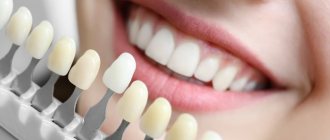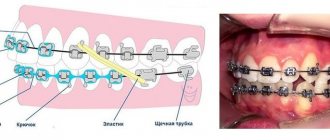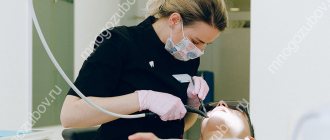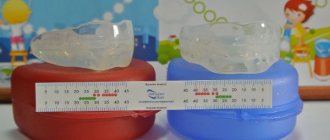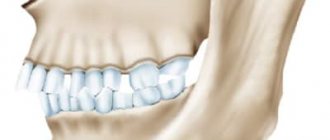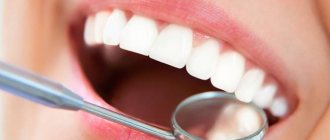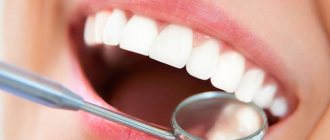The normal state of the dentition involves contact with contact points - the lateral surfaces of the teeth. A deviation from the norm, in which a large gap appears between adjacent elements, is called trema or diastema in dentistry.
This condition disrupts the normal distribution of load on the molars and premolars during chewing, so it requires correction. Orthodontists are involved in restoring such a deficiency, sometimes involving surgeons or prosthetists.
What is the difference
Trema and diastema are two closely related concepts. Trema is a gap between adjacent teeth with a size of 1 mm or more. Such defects appear on both the upper and lower jaws. They can be located in one place, but there are cases of multiple three.
A diastema is a gap between the front teeth – molars. As a rule, it is this that causes the greatest discomfort to a person, since with a size above 1.5 mm it is very noticeable to others.
What is diastema
Sometimes a small gap forms between a person’s central incisors - from 1 to 6 millimeters. This condition is called dental diastema. This pathology can be located both between the upper teeth and between the lower incisors of a person. Diastema is not so rare - in approximately 20% of patients.
“For as long as I can remember, I have always had a gap in my upper jaw. I’ve never had a complex about this. Although the boys in the yard tried to tease me, I whistled louder, and they were jealous. When I went to the dentist at the institute to cure caries, they told me about diastema and advised me to monitor the health of my gums.”
Karina P., review from baby.ru
Causes
Among the reasons that cause the appearance of cracks are hereditary and acquired. Hereditary include:
- similar anomalies in one of the parents - this increases the risk of diastema or trema in the child;
- abnormal size or type of attachment of the labial frenulum;
- increased jaw size;
- small sizes of dental crowns;
- untimely change of teeth;
- anomalies of tooth germs.
Among the reasons that cause the appearance of cracks throughout life are:
- long-term use of a pacifier;
- artificial feeding;
- children's bad habits - biting lips, sucking fingers and other objects;
- loss of teeth without subsequent prosthetics, which causes adjacent elements to move slightly to the side;
- chronic inflammatory gum diseases;
- partial atrophy of the jaw bone.
Sometimes a gap may occur during treatment of an overbite with braces. This is a variant of the norm; the doctor adjusts the strength and direction of the pressure, so by the end of the correction the bite becomes normal.
Dakota Johnson corrected her bite and removed diastema
Surgical plastic surgery
For many patients, the determining factor in choosing a method for eliminating diastema is the cost of therapy. Be sure to consider your financial resources when you and your doctor select a method for correcting a dental gap. Choose the method that suits you best, but do not skimp on your health, as otherwise you may not achieve what you want and spend even more money on eliminating the negative consequences of unsuccessful treatment.
A tooth gap can also be removed using surgical plastic surgery. This technique involves installing dental crowns. Dentists correct the defect by placing ceramic veneers or crowns on the front teeth. This intervention allows you to achieve an excellent aesthetic effect that lasts for many years. Some disadvantage of this technique is its rather high price.
If for one reason or another you cannot use this technique, the doctor can fill the front teeth for corrective purposes, as a result of which the gap will be eliminated. Pay attention to the above method if the diastema occurs a second time or the installation of staples does not bring the desired result.
Types of cracks
In orthodontics, there are four types of diastemas and three:
- false;
- true;
- physiological;
- pathological
False diastema
This condition is most often observed in childhood between 4-6 years. It occurs due to the intensive growth of the skull and jaw bones. Baby teeth that appear in infancy simply become small for the proportions of a growing child. False diastema does not require correction or orthodontic treatment, as it disappears naturally when the mammary row is replaced with a permanent one.
In adults, this type of gap may appear after the removal or loss of lateral incisors due to injury. Sometimes the cause is an abnormality in the shape of the crown while maintaining the normal size of the root. A more rare cause is the presence of an extra molar or premolar that has failed to erupt. In all these cases, the frenulum retains its normal size and attachment site.
True diastema
It is diagnosed after the transition from a replacement set to a permanent one, that is, after the eruption of all permanent teeth. However, there are no other dental defects.
The reason is the ingrowth of a powerful frenulum of the upper lip between the front molars or into the palatal suture.
Physiological trema
This type appears during the mixed dentition, that is, from 6 to 9 years, in rare cases - up to 12. Jaw growth continues, but some dental elements still remain small. This clinical picture does not require treatment.
Pathological trema
This is the presence of a gap in adults who have a fully formed permanent set of teeth.
Definition
Trema is an abnormally large distance between teeth that do not belong to the central zone of the oral cavity. As a rule, such a defect occurs against the background of too small fragments of the jaw row.
It is important to understand that a gap of less than 0.7 mm is not considered a pathology - this is the norm. But anything larger than 1 cm is a dental defect that requires correction.
If a small gap between the teeth does not pose any danger to its owner, then the gap is not as safe as it might seem at first glance.
Treatment
Even with a pathological form, the patient may not experience discomfort for a long time, which often causes a long delay in starting treatment. The diagnosis is made by a dentist performing a preventive examination or treatment. He will refer you for a consultation with an orthodontist to determine treatment tactics.
The choice of the correct method depends on the clinical picture and the reasons why the disorder occurred.
At the moment, all methods of eliminating diastema and trema are divided into the following:
- orthodontic;
- surgical;
- therapeutic;
- prosthetics.
Orthodontic
Moving teeth and minimizing gaps with trema and diastema occurs through the use of special orthodontic devices:
- Dental plates - on the recommendation of a doctor, they are worn constantly or periodically (only during the day or night). This method is most often used at the age of 12-14 years.
- Aligners or aligners . They can also be used for several hours a day or, conversely, only at night. Aligners are made of transparent elastic material, so their use is invisible to others.
- Braces. Choice option for patients over 16 years of age. They can be vestibular, that is, located on the front of the tooth surfaces, or lingual, attached to the inside of the teeth. When using lingual braces, the fact of correcting a diastema or trema remains hidden from other people.
- Miniscrews (microimplants ) - the introduction of small screws into the bone tissue, resulting in rapid orthodontic elimination of dental gaps. When microscrews are used, the support is not other elements of the dentition, but the area of the jaw bone chosen for attachment.
All types of orthodontic correction lead to displacement of not only the crown, but also the root. There is a gradual restructuring of the roots in the bone tissue, which guarantees a stable result. A full course of such therapy takes from six months in childhood to several years in adults.
Surgical
To remove gaps with diastema and trema, two types of surgical procedures are performed:
- Frenuloplasty – excision of the frenulum to change the level of attachment. Performed using local anesthesia, the operation lasts 10-15 minutes.
- Removal of impacted teeth. This operation can be performed under local anesthesia, under sedation or general anesthesia. It all depends on the amount of work and the scale of the intervention, as well as on the individual characteristics of the person being operated on.
Therapeutic
Therapeutic restoration is carried out using orthopedic techniques. The root parts remain in the same places. Such methods in dentistry are called artistic restoration or cosmetic correction.
To get rid of the tooth, the tooth is reconstructed using fillings, veneers or crowns. At the same time, the shade of the enamel, the size and shape of the supragingival part can be changed.
This method is only suitable when the gap is small in size.
Prosthetics
If trema occurs as a result of a long-term absence of a tooth, then the missing element is implanted. This may be part of a comprehensive treatment that includes orthodontic methods.
Diagnosis of diseases
During a visit to the dentist, the doctor must correctly establish a diagnosis in order to determine the severity of the case, plan further actions and select a method of correction. In some cases, a visual inspection is not enough. Then the orthodontist will refer the patient for an x-ray or tomography. Here it is important to exclude or confirm the presence of bone tissue in the problem area. The image will also allow you to see the location of the roots in the jaw and detect underdeveloped tooth buds.
Refusal of treatment
The decision to correct the bite, aimed at getting rid of the gap, is made by the patient. You should know that such a violation carries certain dangers both for dental health and for other systems. Food constantly gets stuck in the cracks and remains there for some time. This greatly increases the risk of caries. The distribution of the load on the cutting edge occurs unevenly, which causes abrasion of the enamel or periodontitis, and possible exposure of the roots. The gap increases over time in almost every case, and in addition, tooth mobility noticeably increases.
Cher Lloyd, a popular participant in the English release of the cult show X Factor after bite correction
In addition, this disorder provokes a deterioration in the functioning of the gastrointestinal tract, since chewing food is not performed as efficiently as necessary.
A large gap allows solid food to enter the mucous membrane, which leads to chronic trauma to the gums. This causes inflammation of the gum tissue, gingivitis.
Another complication is disruption of the temporomandibular joint, which is accompanied by pain while chewing food or talking.
Complications
In the absence of a tight fit of all organs of the dentition, not only external perception suffers. Trema leads to the fact that food fragments constantly get stuck and settle in the interdental openings. When trying to remove them, you can accidentally injure the mucous membrane, soft tissue of the gums, as well as gingival papillae.
And if you try to do this not with a toothpick, but with a harder object not intended for this purpose, you can cause mechanical damage to the enamel surface, or even worse, destroy part of the tooth.
Any of these phenomena is fraught with the development of inflammation, the occurrence of periodontitis, which, at its local stage, can affect entire fragments of organs up to their complete loss.
Tremas also contribute to the formation of bone and gum pockets that are too deep, and this is a serious diagnosis that requires the mandatory intervention of a dentist - such phenomena do not go away on their own.
The almost constant presence of food particles negatively affects the general hygienic condition of the oral cavity and creates favorable conditions for the formation of microbes that destroy not only teeth, but also affect the soft tissue of the gums.
In an advanced state, irreversible processes transfer to bone tissue, and the only solution is surgery. At this stage, the complication is classified as serious and can cause harm to the body.
Prevention
Prevention in 70% of cases eliminates the need to take measures to correct diastema and trema.
What you need to do to avoid this problem:
- Bring your child for preventive examinations to the dentist - this will allow timely removal of the powerful frenulum of the upper lip;
- wean your child off the pacifier as early as possible;
- ensure that infants and preschool children do not develop bad habits (thumb sucking, sucking or chewing on other objects);
- timely prosthetics.
Star Smile offers you a free consultation with an orthodontist to correct three in your city!
And it's not a joke.
The Star Smile company is represented by certified orthodontists in more than 70 cities of Russia and we can offer you a unique opportunity - to simulate your future treatment result in three BEFORE it begins. If you like it, you can decide for yourself which way you want to correct the tremors - with aligners or another alternative method. And do you need to correct the three? Since Star Smile is a leading Russian manufacturer of mouth guards for teeth straightening, our prices for treatment of three teeth are truly the most comfortable for you. And the consultation is free. Would you like us to sign you up for a free consultation on correcting three in your city?
